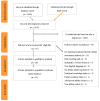Validity of Dietary Assessment in Athletes: A Systematic Review
- PMID: 29207495
- PMCID: PMC5748763
- DOI: 10.3390/nu9121313
Validity of Dietary Assessment in Athletes: A Systematic Review
Abstract
Dietary assessment methods that are recognized as appropriate for the general population are usually applied in a similar manner to athletes, despite the knowledge that sport-specific factors can complicate assessment and impact accuracy in unique ways. As dietary assessment methods are used extensively within the field of sports nutrition, there is concern the validity of methodologies have not undergone more rigorous evaluation in this unique population sub-group. The purpose of this systematic review was to compare two or more methods of dietary assessment, including dietary intake measured against biomarkers or reference measures of energy expenditure, in athletes. Six electronic databases were searched for English-language, full-text articles published from January 1980 until June 2016. The search strategy combined the following keywords: diet, nutrition assessment, athlete, and validity; where the following outcomes are reported but not limited to: energy intake, macro and/or micronutrient intake, food intake, nutritional adequacy, diet quality, or nutritional status. Meta-analysis was performed on studies with sufficient methodological similarity, with between-group standardized mean differences (or effect size) and 95% confidence intervals (CI) being calculated. Of the 1624 studies identified, 18 were eligible for inclusion. Studies comparing self-reported energy intake (EI) to energy expenditure assessed via doubly labelled water were grouped for comparison (n = 11) and demonstrated mean EI was under-estimated by 19% (-2793 ± 1134 kJ/day). Meta-analysis revealed a large pooled effect size of -1.006 (95% CI: -1.3 to -0.7; p < 0.001). The remaining studies (n = 7) compared a new dietary tool or instrument to a reference method(s) (e.g., food record, 24-h dietary recall, biomarker) as part of a validation study. This systematic review revealed there are limited robust studies evaluating dietary assessment methods in athletes. Existing literature demonstrates the substantial variability between methods, with under- and misreporting of intake being frequently observed. There is a clear need for careful validation of dietary assessment methods, including emerging technical innovations, among athlete populations.
Keywords: FFQ; athletes; biomarker; dietary assessment; doubly labeled water; energy intake; food record; sports nutrition; validity.
Conflict of interest statement
The authors declare no conflict of interest.
Figures



References
-
- Manore M.M., Thompson J.L. Energy requirements of the athlete: Assessment and evidence of energy efficiency. In: Burke L., Deakin V., editors. Clinical Sports Nutrition. 5th ed. McGraw-Hill; North Ryde, Australia: 2015. pp. 114–139.
-
- Deakin V., Kerr D., Boushey C. Measuring nutritional status of athletes: Clinical and research perspectives. In: Burke L.M., Deakin V., editors. Clinical Sports Nutrition. 5th ed. McGraw-Hill; North Ryde, Australia: 2015. pp. 27–53.
Publication types
MeSH terms
LinkOut - more resources
Full Text Sources
Other Literature Sources
Medical
Research Materials

